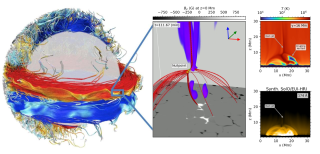Bibcode
Sen, Samrat; Moreno-Insertis, Fernando
Bibliographical reference
Astronomy and Astrophysics
Advertised on:
7
2025
Journal
Citations
5
Refereed citations
4
Description
Context. Forced magnetic reconnection is triggered by external perturbations, which are ubiquitous in the solar corona. This process plays a crucial role in the energy release during solar transient events, which are often associated with electric current sheets (CSs). The CSs can often disintegrate through the development of the tearing instability, which may lead to the formation of plasmoids (magnetic islands, or twisted flux ropes in 3D) in the nonlinear phase of evolution. However, the complexity of the dynamics and the magnetic and thermodynamic evolution due to the coalescence of the plasmoids are not fully understood. Aims. We explore the departure of the CS from its equilibrium configuration through a reconnection process characterized by the formation of plasmoids with a guide field, their mutual approach and eventual coalescence, and we investigate the complex magnetic topology and thermodynamic evolution in and around the merged plasmoids. Methods. We used a resistive magnetohydrodynamic simulation of a 2.5D current layer embedded in a stratified medium in the solar corona, incorporating field-aligned thermal conduction using the open-source code MPI-AMRVAC. Multiple levels of adaptive mesh-refined grids were used to resolve the fine structures that result during the evolution of the system. Results. The instability in the CS was triggered by imposing impulsive velocity perturbations concentrated at three different locations in the upper half along the CS plane. This led to the formation of plasmoids and their later coalescence. We demonstrate that a transition from purely 2D reconnection to 2D reconnection with a guide field takes place at the interface between the plasmoids as the latter evolve from the pre-merger to the merged state. The small-scale, short-lived, and collimated outflows during the merging process share various physical properties with the recently discovered nanojets. The subsequent thermodynamic change within and outside the merged plasmoid region is governed by the combined effect of Ohmic heating, thermal conduction, and expansion/contraction of the plasma. Conclusions. Our results imply that impulsive perturbations in coronal CSs can be the triggering agents for the coalescence of plasmoids. This then leads to the subsequent magnetic and thermodynamic change in and around the CS.
Related projects

The Whole Sun Project: Untangling the complex physical mechanisms behind our eruptive star and its twins
The Sun is a magnetically active star with violent eruptions that can hit Earth´s magnetosphere and cause important perturbations in our technology-dependent society. The objective of the Whole Sun project is to tackle in a coherent way for the first time key questions in Solar Physics that involve as a whole the solar interior and the atmosphere
Fernando
Moreno Insertis